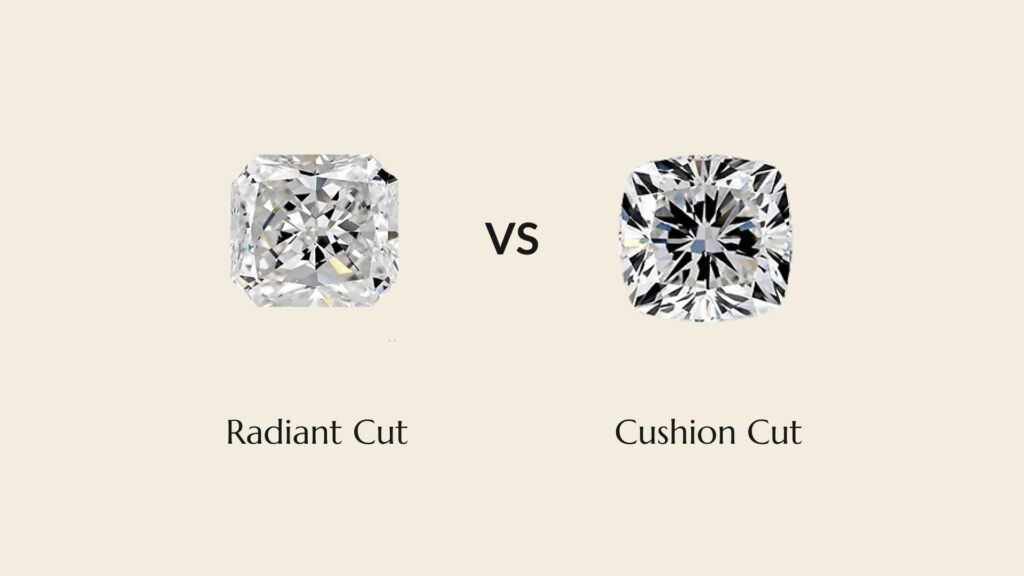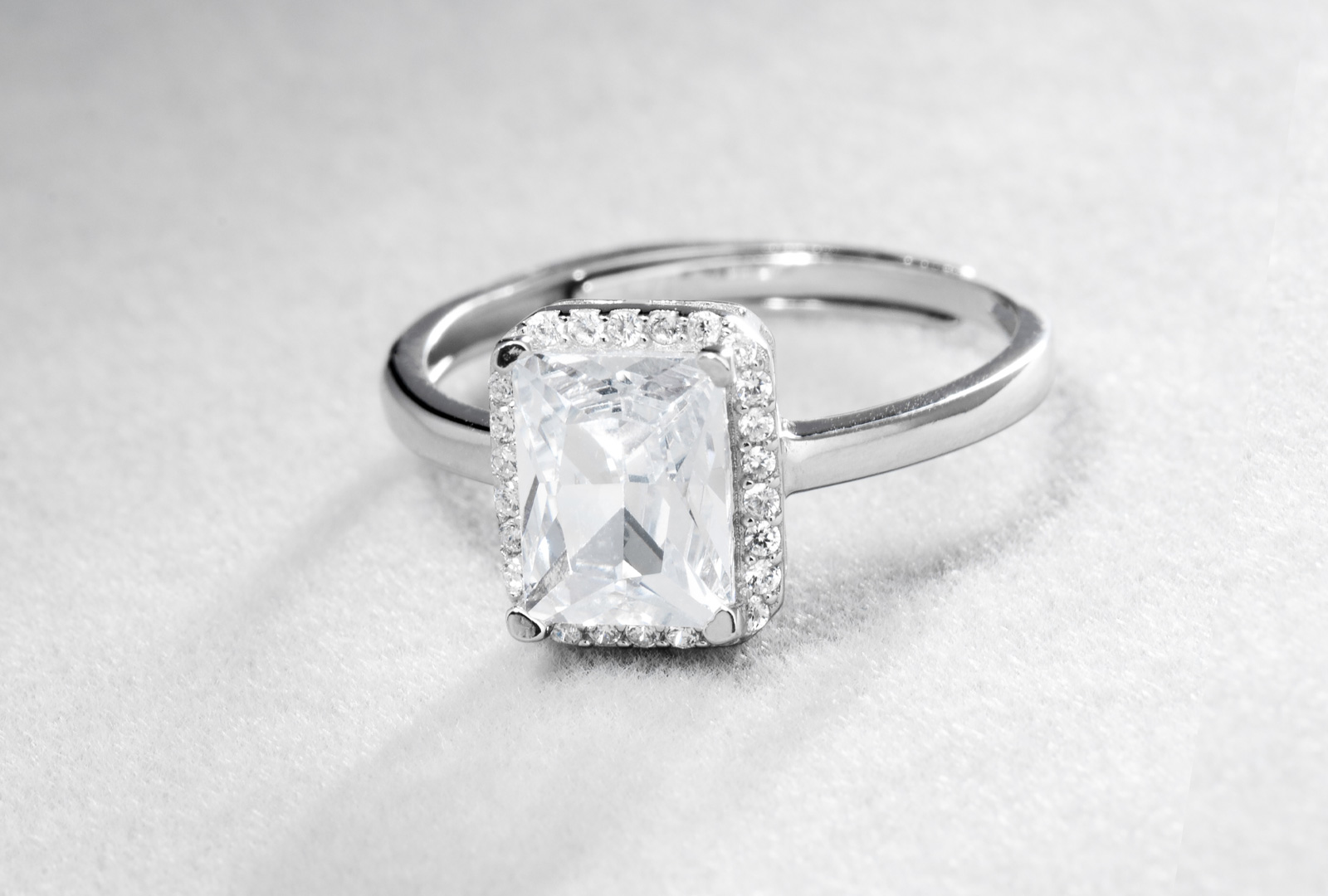Everything You Need to Know About Radiant Cut Diamonds
We’ve explored several diamond cuts already, and now it’s time to take a closer look at the radiant cut. Let’s dive into what makes this shape so popular and why it’s a preferred choice for many when selecting a diamond.
Key Characteristics of Radiant Cut Diamonds
Radiant cut diamonds have a square or rectangular shape with cropped corners, giving them a distinct and modern look. What sets them apart is their 70 facets, which help reflect light and create a lively sparkle, adding to the overall appeal of the cut.
History of the Radiant Cut Diamonds
The radiant cut was first used in 1977 by expert diamond cutter Henry Grossbard. With more than thirty years of experience, Grossbard aimed to create a cut that would optimize the brightness and shine of a diamond. The end effect was a multipurpose form that encapsulated the sparkling facets of a round cut and the extended elegance of an emerald cut.
Although the radiant cut is known for its rectangular, emerald-like form, it can also have a square silhouette, much like a cushion cut. However, the two are clearly distinguished because radiant cut diamonds have many more facets, giving them a unique brightness.
How to Choose the Right Radiant Cut Diamond
- Cut Quality
The cut quality of a radiant diamond determines its appeal. To ensure accuracy, choose diamonds verified by reputable agencies like GIA or AGS, as brilliant-cut diamonds may lack an official cut grade.
- Table Percentage: For exceptional brilliance, the table should preferably be between 61% and 69%.
- Depth Percentage: To balance the quantities of diamonds and light reflection, aim for a depth range of 61%–67%.
- Girdle Thickness: Choose a “Very Thin” to “Slightly Thick” girdle to prevent durability problems without sacrificing style.
- Ideal Depth & Proportions
The dimensions of radiant cut diamonds—whether square or rectangular—greatly affect their brilliance.
- Depth: For best light performance, a depth percentage of 60% to 70% is used.
- Square Radiants: Provide a symmetrical, traditional appearance with a length-to-width ratio of 1.00–1.05.
- Elongated Radiants: With a ratio of 1.10 to 1.30, elongated radiators give off a sleeker, more modern look.
- Best Ratio: The optimal ratio depends on individual tastes. A lower ratio (nearer to 1.00) gives a square form, whereas a larger ratio (1.30 or above) gives a rectangular look.
- Colour
Selecting the appropriate cut depending on your preferences and environment is crucial since radiant cut diamonds emphasize colour more than certain other cuts:
- D-F (Colourless): Expensive and in great demand, especially for platinum or white settings.
- G-J (Near Colourless): An affordable choice with a hint of warmth that is frequently unnoticeable in rose gold or yellow settings.
The radiant cut is a popular option for fancy-coloured diamonds because its faceting structure intensifies the colour’s brightness.
- Clarity
Radiant cut diamonds’ 70 facets help hide inclusions, allowing you to choose a slightly lower clarity grade without compromising beauty.
Size Guide for Radiant Cut Diamonds
The size of a radiant cut diamond is greatly influenced by its proportions. For instance:
- 1.0 carat: Good for anyone looking for an understated style.
- 1.5 carats or more: A more daring option with more visibility.
Because of its enlarged surface area, the elongated form sometimes seems bigger than its carat weight indicates.
Radiant Cut Variations
Radiant cut diamonds are known for their versatility, offering variations in sparkle and shape that cater to individual preferences. Here’s a more detailed breakdown of the two key variations:
Crushed Ice vs. Bow Tie Effect
- Crushed Ice Radiant:
- Features:
The crushed ice radiant cut has smaller, tightly packed facets that create a dynamic and diffused sparkle. Instead of producing distinct flashes of light, this type of radiant cut exhibits a shimmering effect that resembles crushed ice. - Appearance:
Provides a modern and energetic sparkle with a lively and vibrant aesthetic. The scattered brilliance makes it ideal for those who enjoy a subtle yet dazzling light performance. - Best for:
Contemporary designs or those who prefer a softer, understated brilliance.
- Features:
- Bow Tie Effect Radiant:
- Features:
Radiant cuts with larger facets can sometimes create a bow tie effect—a shadowy light pattern resembling a bow tie. This is more common in diamonds with shallower or less optimal cuts. - Appearance:
The bow tie effect adds depth and character to the stone, giving it a unique personality. - Best for:
Those who appreciate bold brilliance with a touch of distinctive charm. A well-cut diamond can minimize the bow tie effect, offering a balanced sparkle.
- Features:
Square vs. Elongated Radiants
- Square Radiants:
- Features:
Square radiant cut diamonds have a 1.00 to 1.05 length-to-width ratio, offering a symmetrical and balanced look. - Appearance:
These diamonds provide a more traditional, modern feel and are often compared to cushion cuts due to their shape. The square proportions create a compact and refined aesthetic. - Best for:
Timeless and classic jewelry designs, such as solitaire or halo settings.
- Features:
- Elongated Radiants:
- Features:
Elongated radiant cuts have a length-to-width ratio between 1.10 and 1.30, creating a sleeker and more elongated silhouette. - Appearance:
This shape provides the illusion of larger size due to its extended surface area and is often used to visually elongate the fingers. - Best for:
Contemporary styles and those who want a more prominent, elegant look. They also work beautifully in east-west settings for a unique design twist.
- Features:
Comparison to Other Diamond Cuts
Radiant vs. Cushion

Although both radiant and cushion cut diamonds are beautiful and versatile, they differ in their qualities. The radiant cut features 70 kite- and triangular-shaped facets that produce exceptional light return and brilliance. Its faceting hides inclusions, and its angular shape gives it a modern look, making it suitable for various settings.
In contrast, the cushion cut has larger facets that create a balance of fire and brilliance, with a softer, rounded square or rectangular shape. While cushion cuts are ideal for vintage-inspired designs, they tend to reveal inclusions more easily.
Radiant vs. Round
Radiant and round cuts are both excellent options, but they cater to different tastes and styles. The radiant cut, with its clipped corners and square or rectangular shape, offers a modern twist on the classic round cut. Featuring 70 facets, it provides exceptional light dispersion and a unique look, blending the angular elegance of emerald cuts with the brilliance of round cuts. Radiant cuts often appear larger for their carat weight, making them a popular choice for those who want a bold, contemporary style.
In contrast, round cut diamonds are one of the most popular shapes, with 58 facets that deliver the highest level of sparkle and brilliance. Known for their timeless appeal and symmetrical design, round cuts are the top choice for traditional engagement rings. Radiant cuts attract those seeking modern shine, while round cuts are favored by those who appreciate classic brilliance.
Radiant vs. Princess
While both radiant and princess cuts are stunning options, their features and designs are different. The radiant cut has triangular and kite-shaped facets that combine the sleek geometry of square or rectangular forms with the brilliance of round cuts to create a dazzling shine. It is a forgiving choice for clarity because of its faceting pattern, which also helps to hide inclusions.
Princess cuts, on the other hand, are square or rectangular, have sharp, pointed corners, and are arranged brilliantly, adding to the fire and shine. Its corners and facets, however, can more easily show inclusions. Princess cuts give a chic and modern appearance that nevertheless maintains its unique form and brilliant brilliance, while radiant cuts offer a modern but unusual appeal.
Best Settings for Radiant Cut Diamonds
Popular Settings
- Solitaire: Highlights the radiant cut’s natural brilliance.
- Halo: Adds extra sparkle by surrounding the diamond with smaller stones.
- Three-Stone: Enhances the radiance with complementary side stones.
Prong vs. Bezel Settings
- Prong Settings: Allow more light to enter the diamond for maximum brilliance.
- Bezel Settings: Provide protection and a sleek, modern look.
Setting Considerations
Choose a setting that complements the diamond’s proportions. For elongated radiants, east-west settings can create a unique, contemporary aesthetic.
Radiant Cut Engagement Ring Designs
There are countless options for engagement ring designs with radiant cut diamonds, ranging from simple solitaires to elaborate halos.
[it would be better if we had our own images, like the one in the middle]
Why Choose a Radiant Cut Diamond?
- Combination of Brilliance and Elegance: Radiant cuts blend the flaming brilliance of round diamonds with the delicate outlines of emerald cuts.
- Perfect for Diamonds with Vibrant Colours: The radiant cut is a popular option for coloured diamonds because it brings out the depth and brilliance of the colour.
- Versatile Design: Performs well in a range of configurations, such as three-stone, halo, and solitaire designs.
- Unique Sparkle: Provides a captivating radiance that attracts attention from all directions.
Anyone who appreciates sparkle and adaptability should consider radiant cut diamonds. The radiant cut’s classic charm guarantees that it will continue to shine brilliantly for many years to come, regardless of your preference for an elongated or square form.
Look through radiant cut diamond patterns to choose the one that suits your tastes and style!

